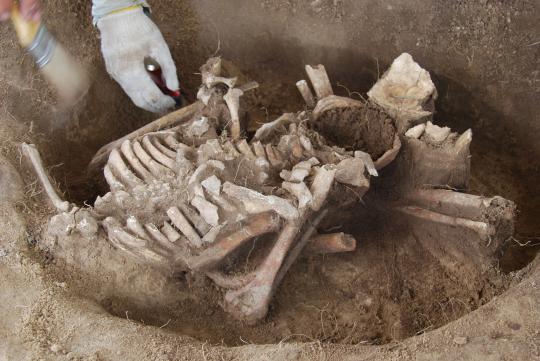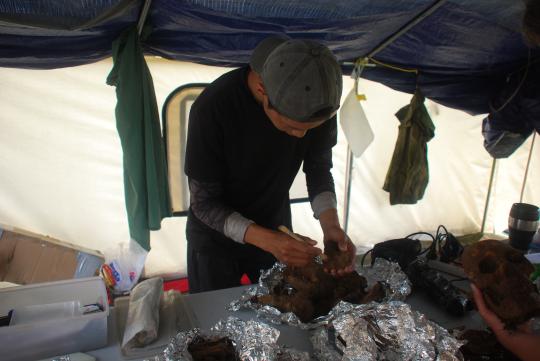
UTSC Archaeologist Lisa Janz and her colleague, Davaakhuu Odsuren of the Mongolian State University of Education, had a running joke that every time they discovered odd bones on their dig in Tamsagbulag, Mongolia, one of them would quip that they might be a human burial.
This is because finding Neolithic human burials in the Gobi Steppe is notoriously difficult. The last time a human burial from this era was discovered was 1976.
But one day this summer, the subject of Prof. Janz and Prof. Odsuren’s running joke became a reality. They were digging test pits outside where they knew the dwellings to be, in order to understand their location relative to the river terrace.
“We actually discovered it by accident,” says Prof. Janz. “Some of our students were excavating and thought they had discovered a big animal bone. They showed it to me, and I immediately knew that it was human skull fragment. It's very distinct, but I didn't really want to get people's hopes up, and sometimes, if you make a mistake, it's kind of embarrassing afterwards. So, I didn't want to get excited until I was sure. And I said, ‘Okay, well, let's put the shovels away and get out our trowels, and let's start excavating slowly.’ And then I said to Odsuren, ‘Okay, so I'm pretty sure that we have a human burial.’ There was just this pause, and it was a tense, tense moment because this is was such a dream for both of us.”
What they found were the skeletal remains of a young woman in the fetal position, legs bent and feet under her head, hands in front of her face. The group began calling the woman Tamsagtsetseg which translates as “The Flower of Tamsagbulag.”
The positioning of the body was unusual, because in many cultures, people are laid out on their back, or side, in an elongated sleeping position. Neolithic burials in this part of the world are often seated, so the person will be tightly placed in a fetal position and sat upright. The body looked like it had placed in the fetal position and then allowed to fall forward or pushed forward. Prof. Janz thinks that this means the body was bundled, as happens among Indigenous people in North America and other parts of the world, which allows the body to be easily carried. In areas where soil is frozen for much of the year like the steppe, it also allows the body to be stored while the community wait for the ground to thaw so it can be buried.
Deposited in the grave with the body was a fox’s upper leg bone, placed next to where the individual’s femur would articulate with their hip bone, as well as deposits of fish bones.
Further study of the woman’s body yielded more insights. Osteological study determined that she was a young woman, small and slender, probably under 5 feet in height. Her teeth were heavily worn, indicating that the plant foods people are were probably ground on stones, with particles of the stones wearing down the teeth.

“This tells us something that we haven't actually been able to see really from the archaeological record of the site,” notes Prof. Janz. “We haven't found large grinding stones yet, but we can see from the teeth that it's likely.”
Lab research might lend further details to what we know about the life of the woman, says Prof. Janz. Tests looking at traces of carbon, nitrogen, strontium or lead can show changes in diet and movement over time. Soil samples from the grave could identify bacteria or parasites present in the woman’s gut at the time of her death. As an important part of Mongolian cultural heritage, the Flower of Tamsagbulag will stay in her homeland, but the next step would be to take small samples of tooth and bone from the body to Canada for analysis.
The Tamsagbulag site is one of the few sedentary Neolithic sites in Mongolia, and two other human burials have been discovered there in the past, one of which was in a house floor. Last year Prof. Janz and her team unearthed a burial of a dog, that can likely be dated to within 100-200 years of the human burial.
“We think that people are probably burying the dead, not in a cemetery, but close to the houses that they're associated with,” explains Prof. Janz. “When we excavate these kinds of pit dwelling houses, it's very rare to find human remains inside the house, but it does happen. It's hard to know, maybe they start a community, and human remains have to be buried under one of the houses, and maybe there's some meaning to that. The other possibility that's just very pragmatic could be that if someone dies in the winter, when the ground is frozen, it could be that the ground around the dwelling is more likely to be thawed, and it would be easier to bury someone. Maybe in an old storage pit or something like that. It's possible that that there's a seasonality to how people are burying in the dead as well.”
“It’s hard to know these things without further research,” she adds. “But the fun thing about archeology is that there are always questions left to answer.”
Prof. Janz was also honoured this summer with an award from the Mongolian Ministry of Culture for services to Mongolian cultural heritage. The award recognizes her as an “advanced cultural worker” and is the second highest honour given out to foreigners by the Ministry. Professor Janz says that the award is indicative of a changing attitude towards women archeologists, and that in almost two decades working Mongolia she is pleased to be helping her colleagues build archaeological capacity in the country while contributing to new important discoveries in cultural heritage, always conscious of the need to help reduce dependence on foreign money and institutions.
“It feels good to be acknowledged,” says Prof. Janz. “I work collaboratively with my colleagues so the awards sort of feels as though it's an acknowledgement of what I've tried to do over the years as a collaborator, and as someone who's excited about Mongolian archaeology and excited about bringing it into important theoretical discussions within the broader archaeological community around the world.”